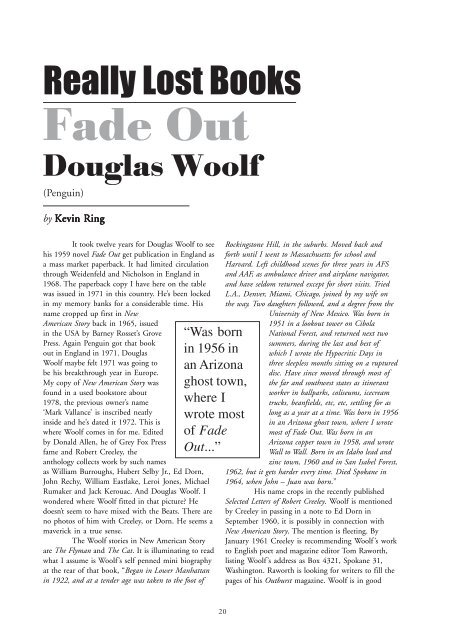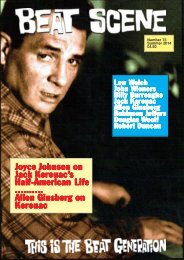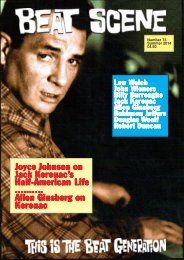Create successful ePaper yourself
Turn your PDF publications into a flip-book with our unique Google optimized e-Paper software.
Really Lost Books<br />
Fade Out<br />
Douglas Woolf<br />
(Penguin)<br />
by Kevin Ring<br />
It took twelve years for Douglas Woolf to see<br />
his 1959 novel Fade Out get publication in England as<br />
a mass market paperback. It had limited circulation<br />
through Weidenfeld and Nicholson in England in<br />
1968. The paperback copy I have here on the table<br />
was issued in 1971 in this country. He’s been locked<br />
in my memory banks for a considerable time. His<br />
name cropped up first in New<br />
American Story back in 1965, issued<br />
“Was born<br />
in 1956 in<br />
an Arizona<br />
ghost town,<br />
where I<br />
wrote most<br />
of Fade<br />
Out...”<br />
in the USA by Barney Rosset’s Grove<br />
Press. Again Penguin got that book<br />
out in England in 1971. Douglas<br />
Woolf maybe felt 1971 was going to<br />
be his breakthrough year in Europe.<br />
My copy of New American Story was<br />
found in a used bookstore about<br />
1978, the previous owner’s name<br />
‘Mark Vallance’ is inscribed neatly<br />
inside and he’s dated it 1972. This is<br />
where Woolf comes in for me. Edited<br />
by Donald Allen, he of Grey Fox Press<br />
fame and Robert Creeley, the<br />
anthology collects work by such names<br />
as William Burroughs, Hubert Selby Jr., Ed Dorn,<br />
John Rechy, William Eastlake, Leroi Jones, Michael<br />
Rumaker and Jack Kerouac. And Douglas Woolf. I<br />
wondered where Woolf fitted in that picture? He<br />
doesn’t seem to have mixed with the Beats. There are<br />
no photos of him with Creeley, or Dorn. He seems a<br />
maverick in a true sense.<br />
The Woolf stories in New American Story<br />
are The Flyman and The Cat. It is illuminating to read<br />
what I assume is Woolf’s self penned mini biography<br />
at the rear of that book, “Began in Lower Manhattan<br />
in 1922, and at a tender age was taken to the foot of<br />
Rockingstone Hill, in the suburbs. Moved back and<br />
forth until I went to Massachusetts for school and<br />
Harvard. Left childhood scenes for three years in AFS<br />
and AAF, as ambulance driver and airplane navigator,<br />
and have seldom returned except for short visits. Tried<br />
L.A., Denver, Miami, Chicago, joined by my wife on<br />
the way. Two daughters followed, and a degree from the<br />
University of New Mexico. Was born in<br />
1951 in a lookout tower on Cibola<br />
National Forest, and returned next two<br />
summers, during the last and best of<br />
which I wrote the Hypocritic Days in<br />
three sleepless months sitting on a ruptured<br />
disc. Have since moved through most of<br />
the far and southwest states as itinerant<br />
worker in ballparks, coliseums, icecream<br />
trucks, beanfields, etc, etc, settling for as<br />
long as a year at a time. Was born in 1956<br />
in an Arizona ghost town, where I wrote<br />
most of Fade Out. Was born in an<br />
Arizona copper town in 1958, and wrote<br />
Wall to Wall. Born in an Idaho lead and<br />
zinc town, 1960 and in San Isabel Forest,<br />
1962, but it gets harder every time. Died Spokane in<br />
1964, when John – Juan was born.”<br />
His name crops in the recently published<br />
Selected Letters of Robert Creeley. Woolf is mentioned<br />
by Creeley in passing in a note to Ed Dorn in<br />
September 1960, it is possibly in connection with<br />
New American Story. The mention is fleeting. By<br />
January 1961 Creeley is recommending Woolf ’s work<br />
to English poet and magazine editor Tom Raworth,<br />
listing Woolf’s address as Box 4321, Spokane 31,<br />
Washington. Raworth is looking for writers to fill the<br />
pages of his Outburst magazine. Woolf is in good<br />
20





